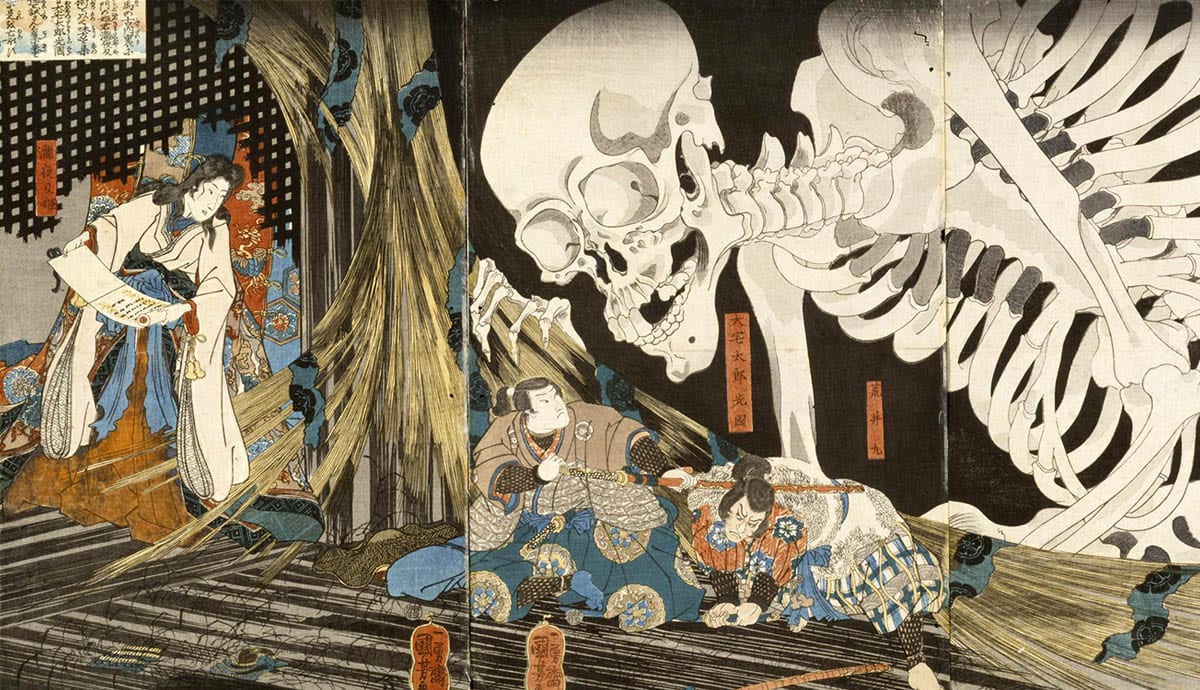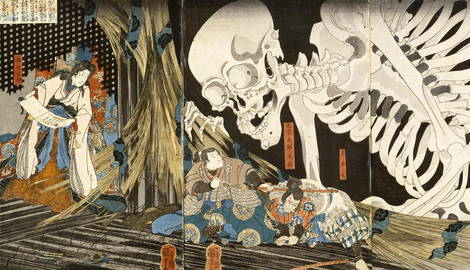
The Edo Period (1615-1868) was a time of political unrest, blurring of class divisions, innovations in art and technology, and a cultural shift in perspective. The mindset behind the Ukiyo-E style encouraged folks to live for the moment as if today was your last. With the creation of Kabuki, the theater doors opened up to everyone, and with them, new ideas and stories came too: making Japanese ghost stories the inspiration for some of the most beloved Kabuki plays and Ukiyo-E works.
Ukiyo-E Art And Philosophy
During Japan’s Edo period, the idea of living in the moment became a communal one, fueling an innovative new style of art called Ukiyo-E. Ukiyo-E, or “floating world,” refers to the practical as well as symbolic properties of woodblock prints. Woodblock prints were made through a collaborative process between painter, carver, and printer, but ultimately, made for a cheaper and much more accessible piece of art. Because the printing blocks could be reused, Ukiyo-E artworks were made in the hundreds, versus previous works such as hanging scroll paintings that were only made once.

As for the symbolic properties of Ukiyo-E, the idea of the floating world and the shared sense of living in the moment is reflected in the writings of Edo author Asai Ryoi, who wrote Tales of the Floating World:
“Living only for the moment, turning our full attention to the pleasures of the moon, the snow, the cherry blossoms and the maple leaves; singing songs, drinking wine, diverting ourselves to just floating, floating; caring not a whit for the pauperism staring us in the face, refusing to be disheartened, like a gourd floating along with the river current: this is what we call the floating world.”
Ukiyo-E art reflected these ideals in the pleasurable subject matter the artists depicted, such as daily city life, the changing of the seasons, erotic works such as Poem of the Pillow, and of course, the wonders of the Kabuki theater.

What Is Kabuki?
At this time, there were three main sources of entertainment in Edo (Tokyo), the Noh theater, reserved for the elite samurai and aristocratic class, Bunraku, or puppet theater, and Kabuki theater.
Kabuki translates to “song, dance, and act,” which accurately describes what would happen in places like the Nakamura theatre, the most popular theater for Kabuki plays. What sets Kabuki aside from the other types of drama is that Kabuki was open for folks of all classes to enjoy. People would come for the whole day to hear stories told in the plays, see their favorite actors perform, and drink tea. Kabuki plays could be rooted in history, mythology, contemporary political commentary, and folk tales. Yūrei (ghosts, apparitions) and Yōkai (demons) stories could be found in all four of these genres.

Japanese ghost stories are one of the subjects that both Ukiyo-E artists and Kabuki actors would represent, acting as a kind of creative bridge for these two worlds to come together. Ukiyo-E artists would be commissioned by Kabuki actors to paint their portraits or to advertise for the upcoming plays, and Kabuki actors would take inspiration from their artistic depictions by adapting poses and mannerisms in their performances.
Let’s dive into three Japanese ghost stories, all of which have a home in the theater and in paper and ink.
1. The Ghost Story Of Oiwa
One of the most popular Japanese ghost stories and one that continues to be retold in films today is Tokaido Yotsuya Kaidan. It was first performed in the Nakamura-za Theatre in Edo in 1825, and though it is highly dramatized, this revenge ghost story isn’t entirely fictional.

This tragic tale follows the young woman Oiwa, who falls into a plot of treachery and betrayal enacted on her by her thieving and lying fiance Iemon, as well as Oume, who is in love with Iemon and wishes to be rid of Oiwa in order to be with him.
The five-act play takes the audience through the complex drama that surrounds Oiwa and her family, and the trail of death that seems to follow all who encounter the doomed Oiwa. One day, Oume sneaks into the stores of Iemon’s familial apothecary in order to concoct a deadly poison that will rid her of Oiwa. It is only when Oiwa applies her skin cream as usual when she realizes she was been betrayed by her fiance and his lover: Oiwa’s hair begins to horrifically fall out in bleeding clumps, and her eye swells up enormously, leaving poor Oiwa looking ghastly and dying a painful death.

In Japanese Edo culture, hair combing was highly ritualistic, complex, and even erotic. The iconic hair-combing scene of the play shows an enraged Oiwa combing her long black hair, reverting this culturally enticing ritual into the stuff of nightmares. Special effects in the theatre emphasized the amount of hair on the stage, the blood, and Oiwa’s sagging and bulging eyes.

After the death of Oiwa, Iemon and Oume are engaged. On the night of their wedding, however, Iemon is haunted by the disfigured ghost of his ex-fiance, who tricks him into slaughtering Oume and her entire family. Oiwa continues to haunt Iemon, and he attempts to escape his horrifying ordeal by becoming a hermit in the mountains. In an attempt to put Oiwa’s spirit to rest, Iemon lights a ritual lantern: only for the face of his vengeful ex to appear from the lantern. Iemon is tormented for the rest of his days by the angry ghost of Oiwa, and like the others who wished ill on Oiwa and her family, dies a tortured death.

Many folks say that to this day, Oiwa’s ghost continues to haunt those who dare to perform in the plays and movies inspired by her life. This comes to no surprise knowing that Oiwa was actually a real person, and in order to appease her restless spirit, actors visit her grave to pay their respects before embarking on their gruesome task.
2. The Ghost Story Of Kohada Koheiji
Another ghost story with elements of facts and fiction is the tale of Kohada Koheiji. Koheiji was actually a Kabuki actor in his life, and although he was denied many roles for his apparently ghastly appearance, he made for a fantastic ghost actor. It is said that he played ghosts so well that he would haunt audiences even from the grave.

In life, Koheiji’s looks not only cost him diverse acting roles, but also the loyalty of his wife. Leaving Koheiji for the likely much more handsome kabuki drum player Adachi Sakurō, and wishing to be rid of Koheiji for good, Otsuka implored her lover to kill Koheiji. And so he did when he tricked Koheiji to join him on a supposed fishing trip. Instead of fishing, Sakurō drowned Koheiji in a swamp.
Now whether or not the next part is historically true, the story unfolds in the plays, A Colorful Companion Tale and the Ghost Story of Kohada Koheiji. The legend says that Koheiji, who was such an accomplished ghost actor in life, used his skills to properly frighten his wife and her lover to death. As the couple lay asleep, a muddy figure appeared in their room. The decomposed skeletal body of Koheiji pulled down the mosquito net surrounding the sleeping couple night after night, and plagued by these hauntings, the two eventually died of madness.

3. The Ghost Story Of Okiku
The story of Okiku originally comes from the Japanese practice of Hyakumonogatari, or, “One Hundred Tales.” While entertaining company, hosts would light one hundred candles and by the light of the fires share a ghost story or spooky encounter they had. One by one, guests would add their own stories, and with each story, a candle would be put out, until they reached the one-hundredth tale. At this point, the room would be dark, all would be crowded in a frightened hush around the final remaining candle, and everyone was prepared for a visit from a ghost.

Okiku’s story has many versions: in one she was a maid at the Himeji Castle, where tourists today can visit “Okiku’s Well,” in another she was testing her lover’s intentions, and in another she was violently tricked by a man she did not love. But all of the versions can agree on Okiku’s iconic and tragic fate and her doomed afterlife.
In the Kabuki play Banchō Sarayashiki, which was adapted from the folk legends for the stage, Okiku is a maid who works for powerful samurai Tessan Aoyama. Aoyama lusts after Okiku and over and over again begs her to be his mistress. Time and time again Okiku refuses him. One day, Aoyama decides to trick Okiku in hopes of forcing her to bend to his wishes. Aoyama hides one of the ten particularly expensive plates that his family owns and accuses Okiku of misplacing the plate while cleaning. Okiku assures him that she did not take or lose it, and goes to count the plates over and over, only for it to come up short every time. Okiku weeps, for she knows that the cost of losing these precious plates is death.

Aoyama offers to absolve her of her alleged crimes, but only if she agrees to be his mistress. Once again Okiku refuses him, and in response, Aoyama ties her up and hangs her over a well, repeatedly dropping her down into the water and pulling her up to beat her. One final time Aoyama demands Okiku to be his mistress to which she wholeheartedly refuses. Aoyama stabs her and drops her down into the depths of the well.

Night after night, Okiku’s ghost rises up from the well to mournfully count each plate, “one.. two.. three…” but before she reaches “ten,” she stops and shrieks in agony for the injustice done to her. Okiku’s nightly weeping, or in some cases, deadly screaming, torments Aoyama and his family. In the folk legends, the family decides to hire an exorcist to put Okiku’s spirit to rest: he yells out “ten!” before she screams and Okiku finally finds peace.

Katsushika Hokusai, one of the most famous Ukiyo-E artists of the Edo period, was the first one to visually interpret the Hundred Tales. In his piece, Okiku’s ghost floats out of the well in the form of a rokurokubi, a demonic creature with an extremely long neck, though cleverly here, her neck is made up of the nine out of ten plates. You can also see Hokusai’s signature use of blue pigment.
Ukiyo-E And Kabuki Today
The invention of woodblock printing would go on to inspire many artists around the world, and indeed whole art movements, such as Art Nouveau. There are still performances of Kabuki plays today, as well as film adaptations of many of these bone-rattling Japanese ghost stories. As for the ghost stories- as in every culture, tales of the dead and curiosity about the supernatural remains a timeless and key part of Japan’s past and present.










